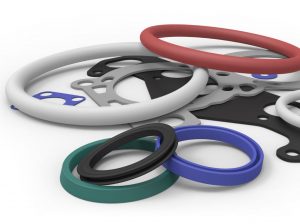 Consulting with a rubber supplier or rubber manufacturer when choosing or designing a rubber product for an application ensures that the application has the essential design features necessary for the application to function properly. Rubber is a unique material—it’s not only a natural material but is a common synthetic material derived from thermosetting or thermoplastic elastomers. The majority of products referred to as rubber are actually one of these types of elastomers.
Consulting with a rubber supplier or rubber manufacturer when choosing or designing a rubber product for an application ensures that the application has the essential design features necessary for the application to function properly. Rubber is a unique material—it’s not only a natural material but is a common synthetic material derived from thermosetting or thermoplastic elastomers. The majority of products referred to as rubber are actually one of these types of elastomers.
A rubber manufacturer or rubber supplier can break down rubber design features such as rubber tolerance, chemical compatibility, a rubber’s material resistance requirements, and secondary operations necessary to finish the product. Being familiar with these factors are not only important but necessary when designing or choosing a product for a specific application.
Essential rubber design features to be aware of and to consider when ordering are:
Rubber Tolerance
Rubber tolerance or, more precisely, dimensional tolerance, is inherent in the manufacture of any rubber material. Measuring final dimensional tolerances can be difficult. For starters, rubber is a flexible material that, in order to work effectively, contracts and expands during usage. On top of that, some rubber products are cut from rubber strips or sheets; others are molded to a particular shape. In either instance, the material is subject to a number of variables in production that other solid materials like metal, wood or plastics are not.
Fortunately, a rubber manufacturer will work to minimize these variables to an acceptable final tolerance that meets the tolerance tables published by the Rubber Manufacturers Association (RMA). The tolerance tables help rubber suppliers communicate with their customers across a wide variety of industries.
Chemical Compatibility
Rubber products are mostly manufactured with different kinds of thermosetting and thermoplastic elastomers. The manufacture of these materials is designed for specific products that require properties unique to their application. One important property is to offer varying resistance to different chemicals that they come into contact with. A rubber product or component can be designed for a benign environment or a highly corrosive one. Chemical compatibility ensures that the right material is used for the right application. Always check that the material is chemically compatible with the intended application.
Material Resistance or Hardness
The hardness of rubbers and like elastomers is an essential design feature to determine the material’s resistance. That hardness is referred to as its durometer. To add to the confusion, a durometer is not only a form of measurement that indicates the hardness of material but is also the name of the instrument or gauge that is used to measure that hardness.
The Shore durometer specifically measures the hardness of rubbers and elastomers. During manufacturing processes, the durometer is used to ensure that the material results in the level of hardness required for a given application, such as a gasket or tire. The material must have resistance to localized deformation when a force is applied to it. Material resistance is an important factor to consider when specifying a material from rubber suppliers.
Final Shape: Molding, Trimming, Deburring, Hollowing
Molded rubber products or parts are manufactured using a mold cavity that is cut to represent the desired geometry of the finished rubber product. Its final shape can be affected by dimensional tolerances, i.e., the variations that occur in the dimensions of a cut part. When molded, rubber parts can have minor variations resulting from the dimensions of a mold’s cavity, common shrinkage that may occur during curing or cooling, or the shrinkage that may occur to the base elastomeric compound used in producing the material.
Secondary operations are essential design features that occur during post-molding. Trimming, deburring and hollowing of rubber parts are common applications that can also result in dimensional variation of finished parts. Be aware when ordering or designing parts through a rubber manufacturer or if consulting with a rubber supplier, that tolerance friendly geometries of rubber parts are favorable to secondary operations, mass production, will have less dimensional variation and are more cost-effective.


